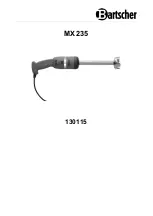
2
English
Deutsch
Español
Français Português
日本語
简体中文
AM120MKIII / AM220 / AM220P
AM120MKIII / AM220 / AM220P
AM120MKIII / AM220 / AM220P
AM120MKIII / AM220 / AM220P
4. Main L and R Outputs
These two ports will output the final unbalanced (balanced
on the AM220) line level signal send from the main mix.
The primary purpose of these jacks is to send the main
output to external devices, which may include power am-
plifiers (and, in-turn, a pair of speakers), other mixers, as
well as a wide range of other possible devices (equalizers,
crossovers, etcetera).
5. Stereo AUX Return (AM220 / AM220P)
These ¼” TS inputs are for the return of audio to the
AM220 or AM220P mixer. This can possibly include the
return signal from external signal processors, or – if really
needed – they can also be used as additional inputs. The
AUX return level control is found on the face of the mixer.
The stereo AUX return can also accept mono signals,
where plugging the ¼” phone jack of any device into the
left stereo input will cause the signal to be duplicated to
the right input. This does not work in reverse.
6. AUX Send (AM220 / AM220P)
This ¼” TS output may be used to connect external input
devices such as effect processors or amplifiers and speak
-
ers (depending on your application). This output is only
featured on the AM220 and AM220P and cannot be found
on the AM120 MKIII.
MAKING CONNECTIONS
Inputs and Outputs
1. XLR microphone Jacks
These jacks accept typical -pin XLR
inputs for balanced and unbalanced
signals. They can be used in con-
junction with microphones – such as
professional condenser, dynamic or
ribbon microphones – with standard
XLR male connectors, and feature
low-noise preamplifiers, serving for
crystal clear sound replication. Each
of the AM series mixers features one
standard XLR microphone inputs for
your convenience.
NB.
When these inputs are used with condenser microphones, the
Phantom Power should be activated. However, when the Phantom
Power button is engaged, single ended (unbalanced) microphones
and instruments should not be used on the mic inputs.
2. Line Inputs
This input accepts typical ¼” TRS or TS inputs, for balanced
or unbalanced signals. There are various numbers of these
inputs depending which mixer you are using. They can be
used in conjunction with various line level devices such as
keyboards, drum machines, electric guitars, and a variety
of other electric instruments.
3. Stereo Channels
Each of the AM series mixers feature a few stereo channels
thrown in for maximum flexibility. Each of these stereo chan
-
nels features two ¼” TRS phone jacks, for the addition of
various line level input devices, such as electric keyboards,
guitars and external signal processors or mixers. These
stereo channels can also be used as mono channels,
where the signal from any ¼” phone jack plugged into the
left stereo input will cause the signal to be duplicated to the
right input also. This does not work in reverse.
1
2
4
5
6







































